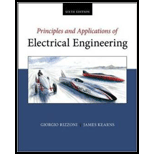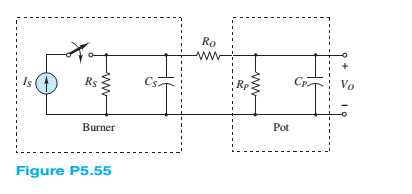
Concept explainers
The burner and pot of Problem 5.54 can be modeled as shown in Figure P5.55.
a. Find the final temperature of the water in the pot—that is,find
b. How long will it take for the water to reach 80percent of its final temperature?
Hint: Neglect

Want to see the full answer?
Check out a sample textbook solution
Chapter 5 Solutions
Principles and Applications of Electrical Engineering
- f 2- For resistive load, measured the output voltage by using oscilloscope, then sketch this wave.. 3- Measure the average values of Vɩ and Iɩ . 4- Repeat steps 2 & 3 but for R.L load.arrow_forwardA single-phase 10 kVA, 1000/100V transformer has the relative voltage parameters of: εrcc = 6%, εxcc = 8%, core losses Pfe = 200W and nominal copper losses of Pcu = 300W.A load of 2 < 30° Ω is connected to the secondary of the transformer. Determine using pu ́s calculations:to. The voltage in the primary, if the voltage of the secondary (at load) is 100 V.b. If the voltage in the primary remains constant at 1000 V, what would be the voltage at the load?c. The voltage regulation of the transformer under the conditions b.d. The efficiency of the transformer under the conditions b.arrow_forward9.38 For the op-amp circuit of Fig. P9.38:(a) Obtain an expression for H(w) = Vo/Vs in standard form.(b) Generate spectral plots for the magnitude and phase ofH(w), given that R1 = 99 kW, R2 = 1 kW, and C = 0.1 μF.(c) What type of filter is it? What is its maximum gain?arrow_forward
- A short 3-o transmission line with an impedance of (6+j 8)2 per phase has receiving end of 22000 kw, 120 KV, 0.8 lagging p.f. Determine (i) Sending voltage (ii) Sending current (iii) Sending power factor (iv) voltage regulation.arrow_forward9.37 For the op-amp circuit of Fig. P9.37:*(a) Obtain an expression for H(w) = Vo/Vs in standard form.(b) Generate spectral plots for the magnitude and phase ofH(w), given that R1 = 1 kW, R2 = 4 kW, and C = 1 μF.(c) What type of filter is it? What is its maximum gainarrow_forwardI need a detailed drawing with explanation Solve es 4 = -20125 شكا +981X914 pv + 96852 الإنجليزية (second order differential I need an example on the subject the partition method and the Laplace method. Suggest an easy equations) and you solve it using and simple example for me and solve it using two methods, only one example. 750 01 95Parrow_forward
- Not use ai pleasearrow_forwardし الإنجليزية (second order differential I need an example on the subject the partition method and the equations) and you solve it using Laplace method. Suggest an easy and simple example for me and solve it using two methods, only one example. الله X 9.01 P+96erarrow_forwardI need an example on the subject (second order differential equations) and you solve it using the partition method and the Laplace method. Suggest an easy and simple example for me and solve it using two methods, only one example.arrow_forward
- 5- Discuss your resultsarrow_forwardWrite a program to flash three LED's connected to ports (8, 9 & 10) respectively as shown below: (Note: T₁-T3-5s & T₂=3s) LED, (pin 10) 2. Suen LED₂ (pin 9) LED, (pin 8) T₁'T' T'arrow_forward3- Draw the waveform for the cct. shown in fig.(2) but after replaced Di by thyristor with a 30°, 90° . 4- Draw the waveform for the cat shown in fig.(2) but after replaced D1 and D3 by thyristors with α = 30° and a2 = 90°. V₁ Det Ve DAX 뭔가 No Fig. (2)arrow_forward
 Introductory Circuit Analysis (13th Edition)Electrical EngineeringISBN:9780133923605Author:Robert L. BoylestadPublisher:PEARSON
Introductory Circuit Analysis (13th Edition)Electrical EngineeringISBN:9780133923605Author:Robert L. BoylestadPublisher:PEARSON Delmar's Standard Textbook Of ElectricityElectrical EngineeringISBN:9781337900348Author:Stephen L. HermanPublisher:Cengage Learning
Delmar's Standard Textbook Of ElectricityElectrical EngineeringISBN:9781337900348Author:Stephen L. HermanPublisher:Cengage Learning Programmable Logic ControllersElectrical EngineeringISBN:9780073373843Author:Frank D. PetruzellaPublisher:McGraw-Hill Education
Programmable Logic ControllersElectrical EngineeringISBN:9780073373843Author:Frank D. PetruzellaPublisher:McGraw-Hill Education Fundamentals of Electric CircuitsElectrical EngineeringISBN:9780078028229Author:Charles K Alexander, Matthew SadikuPublisher:McGraw-Hill Education
Fundamentals of Electric CircuitsElectrical EngineeringISBN:9780078028229Author:Charles K Alexander, Matthew SadikuPublisher:McGraw-Hill Education Electric Circuits. (11th Edition)Electrical EngineeringISBN:9780134746968Author:James W. Nilsson, Susan RiedelPublisher:PEARSON
Electric Circuits. (11th Edition)Electrical EngineeringISBN:9780134746968Author:James W. Nilsson, Susan RiedelPublisher:PEARSON Engineering ElectromagneticsElectrical EngineeringISBN:9780078028151Author:Hayt, William H. (william Hart), Jr, BUCK, John A.Publisher:Mcgraw-hill Education,
Engineering ElectromagneticsElectrical EngineeringISBN:9780078028151Author:Hayt, William H. (william Hart), Jr, BUCK, John A.Publisher:Mcgraw-hill Education,





